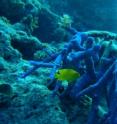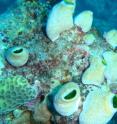Tropical coral could be used to create novel sunscreens for human use, say scientists
Related images
(click to enlarge)
Researchers at King's College London have discovered how coral produces natural sunscreen compounds to protect itself from damaging UV rays, leading scientists to believe these compounds could form the basis of a new type of sunscreen for humans. The team has begun to uncover the genetic and biochemical processes behind how these compounds are produced and eventually hope to recreate them synthetically in the laboratory for use in developing sun protection.
This month, as part of the three-year project funded by the Biotechnology and Biological Sciences Research Council (BBSRC), the King's team collected coral samples for analysis from the Great Barrier Reef, a collaboration with Dr Walter Dunlap from the Australian Institute for Marine Science and Prof Malcolm Shick from the University of Maine USA.
Coral is an animal which has a unique symbiotic partnership with algae that lives inside it -- the algae use photosynthesis to make food for the coral and the coral waste products are used by the algae for photosynthesis. Because photosynthesis needs sunlight to work, corals must live in shallow water, which means they are vulnerable to sunburn.
Dr Paul Long, Senior Lecturer from the Institute of Pharmaceutical Science at King's College London, who is leading the project, said: 'We already knew that coral and some algae can protect themselves from the harsh UV rays in tropical climates by producing their own sunscreens but, until now, we didn't know how.
'What we have found is that the algae living within the coral makes a compound that we think is transported to the coral, which then modifies it into a sunscreen for the benefit of both the coral and the algae.
'Not only does this protect them both from UV damage, but we have seen that fish that feed on the coral also benefit from this sunscreen protection, so it is clearly passed up the food chain.
'This led us to believe that if we can determine how this compound is created and passed on, we could biosynthetically develop it in the laboratory to create a sunscreen for human use, perhaps in the form of a tablet, which would work in a similar way.
'We are very close to being able to reproduce this compound in the lab, and if all goes well we would expect to test it within the next two years.'
A long-term goal of the King's study is to look at whether these processes could also be used for developing sustainable agriculture in the Third World, as these natural sunscreen compounds found in coral could be used to produce UV-tolerant crop plants capable of withstanding harsh tropical UV light.
'The part algae play in protecting itself and coral against UV is thought to be a biochemical pathway called the shikimate pathway, found only in microbes and plants. If we could take the part of the pathway that the coral generates, and put this into plants, we could potentially also utilise their shikimate pathway to make these natural sunscreens,' said Dr Long.
'If we do this in crop plants that have been bred in temperate climates for high yield, but that at present would not grow in the tropics because of high exposure to sunlight, this could be a way of providing a sustainable nutrient-rich food source, particularly in need for Third World economies,' he concluded.
Not only has the study revealed the potential of the coral's compound to protect both humans and crops from the sun, but Dr Long's team is also looking for clues as to how climate change is leading to coral 'bleaching', which can lead to coral death.
Bleaching occurs when a rise in sea temperature (by 2-3 degrees more than the summer average) means the algae is lost from the coral tissues, and if the relationship between algae and coral is not re-established, the coral may die. In 1998, world-wide temperature anomalies resulted in a global bleaching event causing major coral mortality on 16 percent of the world's coral reefs. As coral reefs provide a habitat for many forms of sea life, this can lead to significant loss.
Following the recent collection of samples from the Great Barrier Reef, the King's team is looking at the genetic and biochemical changes that occur when coral is exposed to light at higher water temperatures. It is thought that this study will contribute vital knowledge for management and conservation of reef biodiversity in the context of global warming.
Source: King's College London
Other sources
- Sunscreen pill within five years?from UPISat, 3 Sep 2011, 16:00:43 UTC
- Sunscreen pill within five years?from UPIFri, 2 Sep 2011, 22:30:13 UTC
- Tropical coral could be used to create novel sunscreens for human use, say scientistsfrom PhysorgWed, 31 Aug 2011, 10:30:28 UTC
- Sunscreen pill could be available within five years, scientists sayfrom The Guardian - ScienceWed, 31 Aug 2011, 7:30:37 UTC
- Tropical coral could be used to create novel sunscreens for human use, say scientistsfrom Science DailyWed, 31 Aug 2011, 2:30:14 UTC
- Coral could lead to sunscreen pillfrom BBC News: Science & NatureWed, 31 Aug 2011, 0:00:22 UTC

